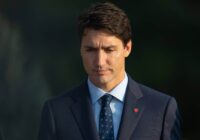In the early morning on July 2, Corey Hurren, a 46-year-old military reservist from Manitoba, rammed his pickup truck through the front gate of the grounds at Rideau Hall, which houses the official residence of the governor general of Canada and Rideau Cottage, the temporary residence of Prime Minister Justin Trudeau and his family. Armed with four weapons — a revolver, two shotguns, and a newly-banned Norinco M14 rifle — Hurren was arrested by the Royal Canadian Mounted Police (Canada’s federal police corps) after a 90-minute stand-off. Hurren currently faces 22 charges, including “knowingly utter[ing] a threat to Prime Minister Justin Trudeau.”
Hurren’s motives remain somewhat unclear. In a handwritten two-page letter found on his person, he expressed a litany of grievances, including fears over the suspension of Parliament due to the ongoing pandemic and the possibility that the country, under Trudeau’s leadership, was on its way to a communist dictatorship. Such a list sits alongside what has been described in the Canadian press as a mixture of “personal despair and financial distress.”
The Far Right Has a History of Infiltrating the British Army
Hurren’s exact motivation for this act remains somewhat nebulous. He has a long history of being drawn to conspiracy theories, including QAnon, a radical-right conspiracy theory detailing a supposed plot by an alleged deep state against US President Donald Trump and his supporters. The incident itself took place in the immediate aftermath of a protest on Parliament Hill, which saw a few hundred of far-right protesters descending on Ottawa to call for the prime minister to be prosecuted for diverse alleged crimes. These factors have led some analysts, including myself, to wonder whether this represented yet another incident of Canadian military personnel being in ideological alignment with radical-right groups.
The Threat
The threat posed by the presence of military personnel in radical-right groups is a growing concern across NATO member countries, but the full extent of the problem remains unclear. Over the past few months, Ondrej Hajn and I have so far identified 213 individual cases of military personnel from the United Kingdom, Canada, Germany and the United States discharged or prosecuted for their participation in radical-right groups since 2010. Only a fraction of cases involving soldiers discharged or prosecuted for harboring links to the radical right is available through open source information.
While these numbers may at first glance seem insignificant compared to the overall size of these nations’ armed forces, two factors are worth bearing in mind. Firstly, publicly available information about individual military personnel involved in radical-right groups is extremely hard to come by. In fact, while our dataset records 14 cases in Canada, an internal document from the Canadian Armed Forces’ (CAF) Military Police Criminal Intelligence Program found that 53 CAF personnel were identified as being part of hate groups between January 2014 and November 2018. This indicates that our dataset only represents the tip of the iceberg.
Daniel Koehler’s fantastic report on the issue paints a much grimmer picture but stops short of identifying individual cases, as we have sought to do. In fact, in the majority of cases, the information was not disclosed by the military itself but instead comes from media outlets, internet sleuths and law enforcement. Secondly, history has shown us the potentially disastrous consequences of letting such radical-right ideologies fester within the ranks of NATO militaries, giving succor to violent, racist ideologies that might lead to vigilante-style attacks.
The threat posed by military personnel in radical-right groups became apparent in the immediate aftermath of the Oklahoma City bombing, when Timothy McVeigh, a US Army veteran radicalized by anti-government rhetoric and interactions with members of radical-right militias, killed 168 people with a truck bomb. However, the events of September 11 and the resultant global war on terror largely sidelined concerns about extremism within military ranks. In 2008, the FBI warned that radical-right groups were “making a concerted effort to recruit active-duty soldiers and recent combat veterans.” The report further highlighted that “military experience is found throughout the white supremacist extremist movement as the result of recruitment campaigns by extremist groups and self-recruitment by veterans sympathetic to white supremacist causes.”
These warnings would prove to be prophetic, and the intersection of individuals aligned with radical-right groups and the military appear to have plagued almost every NATO member country, where radical-right groups have deliberately attempted to recruit individuals with military experience to “exploit their skills and knowledge derived from military training and combat.”
Hateful Conduct
Despite clear indication that the presence of military personnel among radical-right groups poses both a serious security threat and can be a detriment to unit readiness and successful deployment, Western militaries have been generally tight-lipped about their efforts to root out such individuals. A notable exception is the German Military Counterintelligence Service (MAD), which recently released its first publicly available report on extremism within the German federal defense forces, the Bundeswehr. (An English overview of this report can be found here.)
Another positive step is last month’s unveiling of the new Canadian Armed Forces policy on hateful conduct. The policy provides a formal definition of hateful conduct as “an act or conduct, including the display or communication of words, symbols or images, by a CAF member, that they knew or ought reasonably to have known would constitute, encourage, justify or promote violence or hatred against a person or persons of an identifiable group, based on their national or ethnic origin, race, colour, religion, age, sex, sexual orientation, gender identity or expression, marital status, family status, genetic characteristics or disability.”
Prior to the unveiling of this policy, defining hateful conduct was a task which had previously proven difficult for military brass. Members found to have violated the policy can face administrative or disciplinary action that can range from mandatory education, counselling and treatment to having their cases investigated by military police.
Along with the new policy, the Canadian Armed Forces announced that it will be implementing a new system to help monitor and track any suspected incidents of hateful conduct within its ranks. While details about this new system remain scarce, it has been reported that it will resemble the system created to monitor sexual misconduct in the ranks.
While this new policy and the monitoring mechanism are clearly a step in the right direction that acknowledges the severity of the problem and the importance of addressing it in order to make the Canadian Armed Forces a more inclusive organization, it nonetheless falls short on several points. First, the new policy could be seen as a way of potentially decriminalizing hateful conduct within the CAF’s ranks. As argued by Colonel Michel Drapeau, “Under the new policy, the CAF has distanced itself from the Criminal Code, inviting commanding officers and members of the chain of command to treat any such wilful hateful conduct as an administrative, disciplinary matter.”
Secondly, cases of hateful misconduct will continue to be dealt with behind closed doors, which makes it particularly hard for journalists, scholars and concerned members of the public to examine the full extent of the phenomenon. Without direct access to this data, scholars and the public will have to continue relying on open source data, which only paints a partial picture. Lastly and perhaps most importantly, while this new policy and the recent report from the German MAD are encouraging, the phenomenon has yet to be examined and tackled in a comparative way across all NATO countries, signaling a lack of efforts to coordinate practices and lessons learned amongst NATO member states concerning an increasingly transnational terror issue.
*[The Centre for Analysis of the Radical Right is a partner institution of Fair Observer.]
The views expressed in this article are the author’s own and do not necessarily reflect Fair Observer’s editorial policy.
Support Fair Observer
We rely on your support for our independence, diversity and quality.
For more than 10 years, Fair Observer has been free, fair and independent. No billionaire owns us, no advertisers control us. We are a reader-supported nonprofit. Unlike many other publications, we keep our content free for readers regardless of where they live or whether they can afford to pay. We have no paywalls and no ads.
In the post-truth era of fake news, echo chambers and filter bubbles, we publish a plurality of perspectives from around the world. Anyone can publish with us, but everyone goes through a rigorous editorial process. So, you get fact-checked, well-reasoned content instead of noise.
We publish 2,500+ voices from 90+ countries. We also conduct education and training programs
on subjects ranging from digital media and journalism to writing and critical thinking. This
doesn’t come cheap. Servers, editors, trainers and web developers cost
money.
Please consider supporting us on a regular basis as a recurring donor or a
sustaining member.
Will you support FO’s journalism?
We rely on your support for our independence, diversity and quality.






